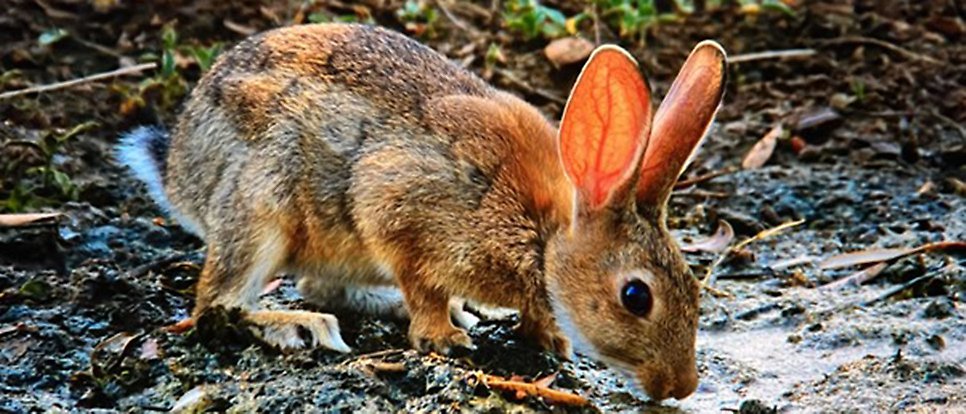How the domestic rabbit became a marauding invader

Wild European rabbit, individual photographed in its native range in Iberia. Photo: Alberto Redondo
How do rabbits go from fluffy pets to marauding invaders? Until now the secret of their success has been a mystery. In a new study an international consortium led by scientists from BIOPOLIS-CIBIO (Portugal) and Uppsala University (Sweden) sequenced the genomes of nearly 300 rabbits from across three continents to unveil the key genetic changes that make these animals master colonisers.

Leif Andersson, professor at Uppsala University. Foto: Mikael Wallerstedt
Throughout history, people have taken animals into their care. Your beloved pet – furry kitten, loyal dog or colourful goldfish – is just part of an amazing variety of domestic forms.
“Some have changed so much from their wild ancestors it is difficult to imagine they are related, like chihuahuas descended from wolves,” explains Dr Pedro Andrade, a researcher at BIOPOLIS-CIBIO and first author of the study. “The changes are often so drastic that if you put your pet back in the wilderness, it will be very hard for it to survive.”
But sometimes, they do rise to the challenge. When they do, we call them feral, populations of a once domestic species that have successfully readapted to the wild. Rabbits are a classic example. Through frequent and independent releases, rabbits have colonised locations worldwide. But despite years of research, a central question has eluded scientists: how can a domestic animal, optimised for thousands of years to live in captivity, not only survive but thrive when returned to the wild?
“In a previous study by our team, which looked at the colonisation of Australia by rabbits, we found that multiple releases of domestic rabbits had taken place for several decades before a single introduction of 24 rabbits with wild ancestry in 1859, by Englishman Thomas Austin, triggered the explosive population growth of rabbits which caused one of the largest environmental disasters in history,” says Dr Joel Alves, a researcher at BIOPOLIS-CIBIO and the University of Oxford.
Domestic and wild rabbits
Could this be the key to explaining why rabbits so frequently establish these feral populations? To answer this, the international team of researchers sequenced the genomes of nearly 300 rabbits, including six feral populations from three continents – Europe, South America and Oceania – as well as domestic rabbits and wild rabbits from the native range in Southwest Europe. Armed with this treasure trove of information, the largest genetic dataset for rabbits ever produced, researchers could now understand what makes these introduced rabbits unique.
“Domestic rabbits are so common that our initial expectation was that these feral populations would be composed of domestic rabbits that somehow managed to re-adapt to the wild, but our findings point to a more complex scenario,” explains Dr Miguel Carneiro, one of the senior authors of the study. According to him, “Despite looking at six largely independent colonisations, all these feral rabbits share a mixed domestic and wild origin.”
Genetic variants eliminated
The team found that during re-adaptation to the wild, genetic variants linked to domestication are often eliminated because they are often deleterious in the wild, making animals more vulnerable to predation – a pattern that was more striking depending on how extreme the trait had become during domestication.
“In these feral populations, you will typically not see an albino, or a fully black rabbit, even if these fancy coat colours are very common in domestic rabbits. However, you may very well encounter rabbits that carry the mutation for diluted coat colour, a domestic variant that has minimal effect on camouflage,” adds Dr Leif Andersson, professor at Uppsala University and another senior author of the study, who continues, “This is a concrete example of natural selection in action.”
This purging of domestic traits did not just target fancy coat colours. The team found evidence of strong natural selection operating on genes linked to behaviour and the development of the nervous system.
“Tameness is crucial in enabling domestic animals to live close to humans, but it will not help a rabbit that finds itself back in the wild survive, so natural selection removes the genetic variants linked to tameness,” explains Dr Andrade.
Invasive pests
The study has implications for understanding evolution and will be closely followed by lawmakers and practitioners on the frontlines of conservation. Feral rabbits often turn into invasive pests causing hundreds of millions of dollars in damage, and other domestic-turned-wild animals cause similar problems, like feral pigs or feral cats.
“The best strategy to mitigate the impacts of invasive species is to prevent them from being introduced in the first place, so we hope our study provides important evidence to help evaluate and identify future invasion risks,” Dr Carneiro concludes.
Märta Gross Hulth
Publication:
Andrade, P. et al. (2024). Selection against domestication alleles in introduced rabbit populations. Nature Ecology and Evolution. DOI: 10.1038/s41559-024-02443-3.
